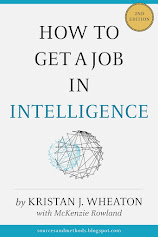A couple of weeks ago, I made a print-and-play version of my new game about collection management, Spymaster, available to anyone who reads this blog and would drop me an email (The offer is still open, by the way, in case you missed it the first time).
Since then, I have mailed out over 100 copies to everyone from the DNI's office to troops deployed in Afghanistan to academics in Japan to the Norwegian police forces!
Feedback is starting to trickle in and the comments have been largely positive (whew!) even from some very experienced collection managers (Thanks!). In addition, I have received a number of outstanding suggestions for enhancing or improving the game. Some of these include:
- Making different collection assets work better or worse against different information requirements.
- Increasing the point value of information requirements collected early.
- Making some of the OSINT cards "Burn - 0" or impossible to burn.
- Giving players a budget and assigning dollar values to each collection asset such that players had to stay within their budget as well.
I recognize that these suggestions may not make much sense if you haven't played the game but all of them (plus many more) are fantastic ideas designed to make the game more real. And therein lies the rub...
One of the classic problems of games designed to simulate some aspect of the real world is the trade-off between realism and playability. Playability is really just how easy it is to play the game. Every time you add a new rule to make the game more realistic, you make the game more difficult to play and therefore less playable. Its not quite as simple as that but it gives you a good idea of how the problem manifests itself. Great games designed to simulate reality often give a strong sense of realism while remaining relatively simple but the truth of it is, like the Heisenberg Uncertainty Principle, the more you try to do one, the less, typically, you are able to do the other.
 The problem of playability versus realism is analogous to the problem of feature creep in project management. Most people have been involved in a project that started out simple but, over time, grew incredibly complex as more and more "good ideas" were added. Each idea, in and of itself, was justifiable but, in the end, led to an unwieldy mess.
The problem of playability versus realism is analogous to the problem of feature creep in project management. Most people have been involved in a project that started out simple but, over time, grew incredibly complex as more and more "good ideas" were added. Each idea, in and of itself, was justifiable but, in the end, led to an unwieldy mess.Figuring out where to draw the line is just as important in game design as it is in project management. This constraint is even more strict when considering the modern intelligence classroom. Here, unless the course is entitled "collection management", there is likely a highly limited amount of time to devote to a game on collection management.
Consider the case of Spymaster. I wanted a game which would replace a one-hour lecture on collection management for our intro classes. To make this work, I would need to be able to set-up the game, explain the rules, play the game and then conduct an outbrief all within an hour. That's pretty tough to do (at least for me) and still make the game meet your learning objectives. It becomes a very careful balance of putting good ideas into the game while not running out of time to play the game in class.
The classic solution to this problem is to have a basic version and an advanced version (or several advanced versions). These can be included in the rules from the outset or added later as expansion packs. Right now, this is exactly what I am doing with all of the feedback I am receiving - scouring it for good ideas I want to put into more advanced versions of Spymaster!





8 comments:
Stella, Please sell your wares elsewhere, OK? This is for comments about using games in the classroom to teach intelligence collection management. We do not want you to spam us with an unrequested advertisement that you don't pay to run on the site.
Sincerely,
Hugh
Hugh,
Thanks for your comments! You are, of course, correct.
Unfortunately, this sort of stuff pops up all the damn time. It comes from people paid to spam and they don't care if it gets deleted or not (on SAM, of course, it does...). They just move on to the next blog.
Again, thanks and glad you enjoy the blog enough to defend its integrity!
Kris
Back to the topic at hand...
Perhaps what you have here is an opportunity to expand the game without necessarily flooding players with additional rules.
1. Consider developing the standard game with a quick and easy set of basic rules and (for the more technically minded who are after longer games and added realism) a slightly more advanced set of rules that build on the basics with a few more granular options.
2. After you've got the core game sorted out, collect all of the additional rules that add the feature creep elements that you like, and combine them into distinct packages that (with new and relevant cards) will become the next tranches of the game to be released....
Eg. After the original game you then get all the new rules and features that tie in together to create the first supplement: SpyMaster 1.2 Collection During the Civil War! Then later on the next collection of linked rules and features with a new set of unique cards in: SpyMaster 1.3 Collection ELINT... etc.
Each 'blister' pack can be played with the core game to enhance it, teach new and unique elements, and even work with other packs to create a super-simulation of high complexity for the die-hard collection management gamers.
The beauty of this modular approach is that it allows players the flexibility to buy and then play the game they want. It extends the playability / lifetime of the core game, and allows you to develop more and continue publishing, ensuring the card game has an ongoing lifecycle.
3. So what else is there to consider other than new rules features? How about expansion packs that tie to a key issue or event or even region, eg:
SpyMaster 2.1 Collection in the Cold War...
3.1 HumInt -strengths and weaknesses, opportunities and threats.
4.1 Collection in the Afghan Conflict - Rise of the Drones.
Oops,
For some reason when reading your original post my iPad didn't show the last paragraph .. Which actually covered everything I've just posted above!
Kindly delete, it's just wasting space.
And good luck with expansion packs!
Post a Comment